Why we shouldn’t centralise the student movement: protest, tactics and ways forward
Features, New in Ceasefire - Posted on Monday, January 3, 2011 11:46 - 9 Comments
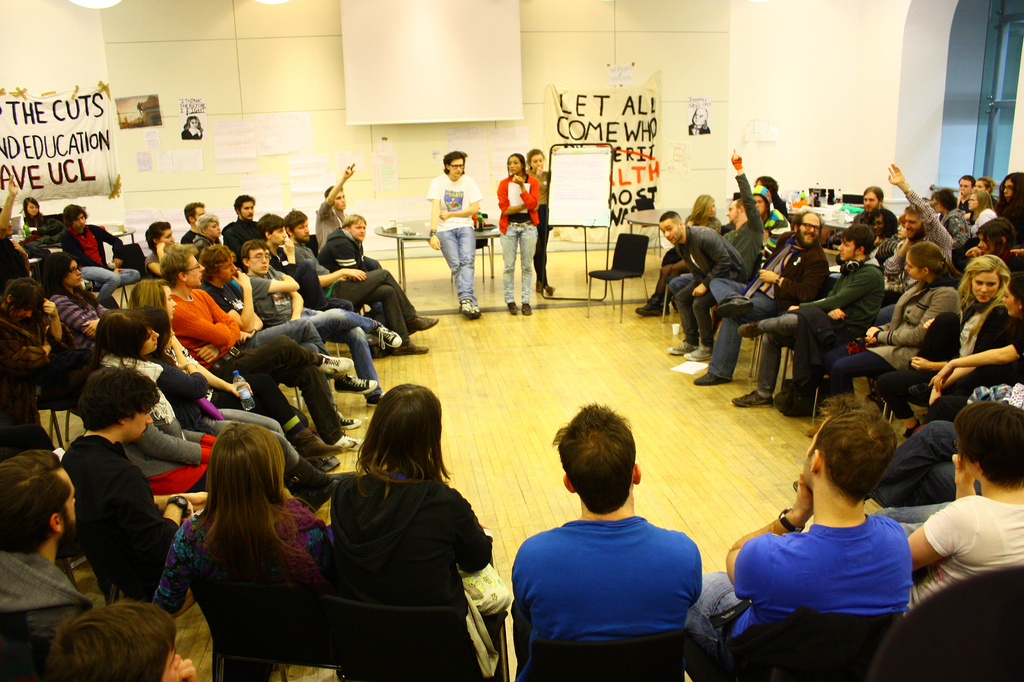
by Markus Malarkey
In the respite from meetings, demonstrations and other acts of resistance to the Con-Dem government provided by the Christmas break, it seems wise to reflect on the recent developments of the student movement against fees and cuts. Reflection on the successes and failures of the movement, which has grown out of the recent wave of university occupations, will allow students and others to learn lessons about how to move forward in the struggle against government policy and police violence. The blogosphere is already swarming with recounts and reflections of occupations and protests. National meetings have been organised for January and inevitably the question of ‘where now?’ is being raised. How should students move forward in their efforts to resist government policies and the actions of the state?
Two key areas of discussion have arisen from this reflection: the form that future protests and mass actions should take, and the possibility of greater organisation and co-ordination across the movement.
Pot vs. kettle
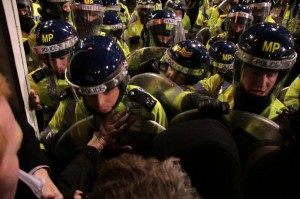 The tactic of kettling protesters has until recently been extremely successful for the police. On the one hand, the kettle confines protesters, limiting the amount of disruption they can cause and their ability to voice opposition. On the other hand, it provokes protesters to violent attempts to ‘break’ and escape the kettle. The violent reaction of protesters is used to create a negative image of resistance. This image subsequently permeates throughout the media’s account of the protest. The police use the violence of protesters, which the kettle itself provokes, to justify future kettles.
The tactic of kettling protesters has until recently been extremely successful for the police. On the one hand, the kettle confines protesters, limiting the amount of disruption they can cause and their ability to voice opposition. On the other hand, it provokes protesters to violent attempts to ‘break’ and escape the kettle. The violent reaction of protesters is used to create a negative image of resistance. This image subsequently permeates throughout the media’s account of the protest. The police use the violence of protesters, which the kettle itself provokes, to justify future kettles.
Additionally it appears that in pitched battles between police and protesters, such as those which recently erupted around Parliament Square, the police have a clear advantage. Besides their body armour, shields and batons, the discipline and training of officers combined with the rigid hierarchy under which they operate allows the police to operate as a cohesive unit in a way that protesters are unable to. When protesters confront police lines in attempts to break out of the kettle, a lack of coordination often makes their attempts chaotic and unsuccessful. Those protesters who want to be at the front often find it hard to push through the crowd. Similarly those who unwittingly find themselves at the front often find themselves pushed into the range of police batons by those behind them and cannot push back through the press. When a police line looks weak it is always difficult to encourage a large enough group to move en masse and break through. Communication at a protest is difficult at the best of times and whilst the spontaneity of the crowd can often catch the police unawares, it is rarely enough to allow protesters to escape containment.
Protests are most effective when they are not kettled. Containment debilitates residence by restricting protesters’ movement and possible courses of action. In avoiding containment, protesters first prevent the creation of a negative image of resistance and second enjoy greater freedom in the forms of their acts of resistance can take. It appears that the form of future protests should enable protesters to avoid containment and thus effectively protest. If protests which take the form of a concentration of people are too easy to contain and debilitate, what form should protests and mass actions take?
Some have suggested that protesters occupy the space inside the kettle, turning it into a camp where protesters can resist attempts by police to incite violence. Such protests would apparently allow protesters to turn containment against the police by creating a positive image of resistance within the kettle. However, given that the effectiveness of containment is partly due to the violent response it provokes from protesters, prompting clashes with police that subsequently dominate the headlines, it seems unlikely that the police would allow protesters to become too comfortable in the kettle. Indeed, at the G20 Summit when Climate Camp set up a camp in the City, scores of riot police moved in and forcibly removed the camp. More recently, the experience of those protesters who were contained in such a tight kettle on Westminster Bridge that some were treated for injuries caused by crushing illustrates that the police wish to make kettled protesters as uncomfortable as possible. By making containment uncomfortable, the police both punish protesters and provoke them to react violently.
Others have called for protests in which groups of protesters are more dispersed and act independently to express their opposition. ‘A new geography of opposition’ has been called for, in which concentrations of protesters are dissolved and dispersed across a much large area. By dispersing, protesters can take advantage of their capability for spontaneous and unpredictable action. The apparent inability of the police to respond rapidly to unfolding events allows for dispersed groups of protesters to outmanoeuvre the police and avoid containment.
The inability of the police to react quickly to unfolding events results from the decision-making structures in place within their organisation. Decision-making is confined to a handful of senior officers. Their ability to rapidly make decisions about how to react to events is restrained by both the small number of officers responsible for decision-making and their limited access to information. When there is a development that needs to be addressed – say some protesters have occupied Top Shop – there is first a delay in the transmission of information to those at the top of the hierarchy. Second, the small number of senior officers limits the speed with which they can respond to the new information. Those at the top find it even harder to respond rapidly when there are multiple events/protests going on simultaneously.
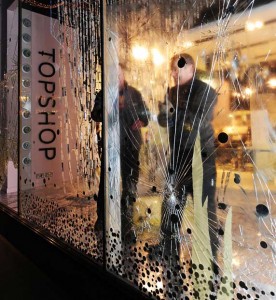
Consider the small group of protesters who laid siege to Top Shop on Oxford Street and effectively closed down the busiest shopping street in the country. After breaking through police lines at the Victoria Street entrance to Parliament Square, the group managed to evade attempts to contain them by remaining mobile. Whilst the police were busy kettling a few thousand students in Parliament Square, this small group managed to extend the protest to the West End and divert substantial police resources.
The police cannot be everywhere; they cannot react as quickly as the mass of protesters can. Groups can and do act autonomously in a way that police officers are completely unable to. If fifty protesters realise that a bank, stock exchange, oil depot, university campus, government office or corporate headquarters is vulnerable to occupation or blockade, they don’t have to wait for the go-ahead from the rest of the protest. They just go. Milbank is a case in point – the police were very slow to respond to the occupation of the building that housed the Conservative Headquarters. Press releases explained that the police had not expected the spontaneous occupation and destruction of Milbank Tower and as such they had been unable to respond rapidly.
The closest example of the type of protest envisaged is that which took place in London on November 30. Instead of marching straight down Whitehall as they had done at the previous demonstration, the crowd splintered into several groups that proceeded to march through central London, playing ‘cat-and-mouse’ with the police. It was the crowd’s spontaneous decision to start marching an hour before the announced time that caught the police off guard. Only when the separate groups had met up again at Trafalgar Square was the protest kettled. It appears that the most successful protests have often been spontaneous and have always taken the police by surprise. The tactics developed by the police to manage protests that are concentrated in a specific area are largely effective at debilitating such protests but completely ineffective when attempting to tackle protests composed of numerous coordinated acts of resistance which are dispersed across a much larger area. Future protests and mass actions should take the form of an insurgency in order to render the efforts of the police to contain and manage resistance completely ineffective.
Organised autonomy, not centralised control
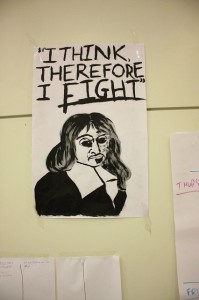 In order for dispersed protests to be really effective at avoiding containment and actively expressing opposition to government policies through resistance, they must be coordinated to a certain degree. Communication between protesters is vital. The question then arises, how should the movement organize itself in order to best achieve the desired level of coordination? And how much should be decided at the national meetings that have been planned for January?
In order for dispersed protests to be really effective at avoiding containment and actively expressing opposition to government policies through resistance, they must be coordinated to a certain degree. Communication between protesters is vital. The question then arises, how should the movement organize itself in order to best achieve the desired level of coordination? And how much should be decided at the national meetings that have been planned for January?
In trying to address these questions, it might be wise to first examine the role that national organisations have had in the movement up until now. The National Campaign against Fees and Cuts (NCAFC) has so far called two days of national action against government policy, days X1 and X2, and one mass demonstration in London. Unlike the NUS, the NCAFC has tried to facilitate student protests rather than direct them toward specific actions. It was enough for student groups and others to know when protests were to take place, the how was left up to them. Similarly, the recent success of UK Uncut actions is largely a result of the freedom local groups have had to organize their own autonomous actions based on their capabilities and specific aims.
Freedom to act autonomously empowers individuals and groups. Attempts to manage and control this movement will lead to disillusion and abandonment. “We’ve been doing fine up until now,” people will say, “why start telling us what to do now?” And they would have a point. As it stands, this movement is arguably the most successful in a generation; it would be unwise to ignore the reasons for this success. One factor in the recent success of students protests has been the refusal of national organisations to attempt to manage the actions of protesters – regardless of whether they would have been able to had they tried. It is enough that they provide support to student groups. This support comes in many forms including the provision of information, practical and legal support and, crucially, a forum to meet and coordinate with other groups and individuals.
There is a balance to be found between complete disorganisation resulting in an inability to coordinate actions at all and the imposition of an organisational structure that rigidifies and centralises decision-making within the movement. As soon as national or local organisations attempt to control the actions of student groups and protesters, the movement will begin to weaken. Reflections on the events that took place within the occupation of the Michael Sadler building at Leeds University make this clear. It was decided at a ‘general assembly’ that no action that endangers the occupation should take place. In other words, only actions approved by the general assembly in the occupation should be taken. This declaration, which branded any action taken without the approval the general assembly as illegitimate and counter-productive, was made as a direct response to the brief occupation of the Arnold Ziff building, which houses the office of Leeds University Vice-Chancellor. Many outside and inside the Sadler occupation regarded the spontaneous occupation of one of the key administrative buildings in Leeds University as a successful action of opposition and resistance. However, the organisational structure within the occupation allowed those who felt threatened by the spontaneous actions of others to condemn them and cause divisions within the occupation and the broader movement.
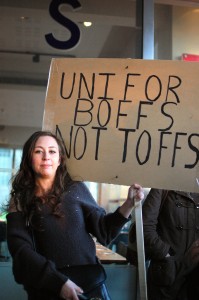
As has already been discussed, the strength of the student movement lies in its capacity for dispersal and for spontaneous, creative and autonomous actions that catch the police unprepared and avoid containment. Different groups and individuals are willing and able to act in different ways; to attempt to direct or restrict their actions will only lead to division. The time set aside for national meetings should not be used to formulate a ‘national strategy’ and subsequently impose it across the movement. This movement is still learning and growing; to impose rigid organisational structures on it at this moment will stifle its growth and make the seemingly impossible actually impossible.
National meetings provide an excellent forum for the exchange of information, discussion and networking between groups. However, they are not the place where decisions regarding the direction and objectives of the student movement should be made. Such decisions do not need to be made at all; the ‘direction’ of the movement is determined by the culmination of actions taken by autonomous groups. Whilst national organisations such a NCAFC and UK Uncut are crucial in providing coordination and support for autonomous groups, this is where their productive role ends. The attempts made by the NUS to pacify student anger and certain groups in occupations such as Leeds University to restrict the actions of protesters have shown that attempts to control and manage a movement such as this are completely counter-productive in the struggle against government policy and state actions.
Moving forward, protesters should improve communication and coordination during and across separate actions. National meeting will provide individuals and groups with opportunities to make links with others and begin to coordinate actions independently of centralised organisation. Dispersal rather than concentration as a form of protest takes advantage of the movement’s strengths whilst exposing the weaknesses of the police. Coordination of action is necessary to avoid chaotic ineffectiveness but at the same time imposition of a rigid organisational structure, which restricts the growth and creativity of the movement, will significantly handicap efforts to resist government imposed austerity measures and other state actions. It is precisely because groups are not highly organised that dispersed protests can and have been so successful. Concentration of power and centralisation of decision-making will play right into the hands of the police, making containment of protest and resistance easier rather than harder.
9 Comments
Bobby
Links of the Day January 3rd « RadicalDandy
[…] Marcus Malarkey at Ceasefire here […]
Jamie
I believe you are right in the assumption that horizontal and acepehalous organisation confuses the police and makes it easier to run around and participate in various bursts of direct action. But so what? I don’t mean to be rude, I’ve been on all the student actions in London, countless smaller ones (for EMA etc) in Oxford, as well as occupying the rad cam here and doing the UK UNCUT stuff. But never have I believed that this is a telos or end in itself. It’s been a consciousness raising exercise certainly, and people are certainly more understanding now about not being able to get their top-up or whatever on a Saturday afternoon and we’ve framed a different discourse to the TINA rhetoric of government austerity (mostly, weve managed to make people question whether tax loopholes for the rich are fair whilst the poorest are being so callously pinched). And it is a similar tale with the student movement, we need to keep going but recognise that we are only a catalyst or detonator. To think we can change UK plc by running around in small groups dressed like ninjas is both potentially dangerous, undemocratic (which seems to be a theme of your narrative) and elitist. After capitalism seemed to self destruct in 2007/8; it’s present transendance, whereby financial productivity is the only remaining concern across all spheres means that students cannot be the agents of change as they do not bring any significant surplus value to the system (if they did, the government wouldn’t have attacked the sector right?) therefore we need to motivate, inspire, shame, embarrass and do whatever necessary to corece or co-opt the trade unions, workers and other sectional interests to join the resistance – these producers of surplus value are the only voice that will be listened too by an elite reliant on the sweat from the backs of the working class. And this will require some paradigm of democratic leadership or else the left will be doomed to relive another glorious failure such as May ’68 (wherein the movements ‘rudderlessness’ eventually drained it of momentum).
Hi
Jamie,
I am interested in what sort of change to UK plc you envisage
x
Jamie Pitman
Well that’s the million dollar question isn’t it!?!
These debates about the student movement are the topic du jour aren’t they and I certainly don’t think I’ve got any special insight or a particular right to prioritise my opinion over any others. I also think it’s too simplistic to reduce the question of leadership to a tension between anarchist and Marxist factions within the movement.
I think most protestors were simply acting out their anger because of the betrayal of a rabidly neoliberal coalition, acting without mandate or compassion. I also think we reacted justifiably to cynical, undemocratic and brutal policing tactics on each of the marches.
This anger has led to the immanent politicisation of many; although possibly a politicisation in the negative sense of ‘neoliberalism / austerity sucks’ or ‘Nick Clegg’s full of shit’, ‘Tory scum’ etc.
This new episteme coupled with all the headlines, the resignation of some ministers, a small amount of sympathetic reporting in the more centrist press, as well as youtube and facebook creating a sort of mechanical solidarity amongst protestors and providing immediate depostions to disprove the lies of police and media ‘witnesses’ – all helped us ride a wave whilst shouting ‘we are not de-ideologised – we are awake; we will fight back and we’re doing very well on our own thank you very much’.
The news that Alfie Meadows had to undergo emergency brain surgery, the spectacle of police pulling Jodie McIntyre from his wheelchair and the subjugation of our legitimate anger to the (at best) comedic story of a horse faced parasite being prodded by a stick further galvanised us and ‘this is only a beginning’ became a mantra for everyone. And rightfully so – everyone’s been ace.
I think the idea we should be leaderless, decentralised etc. is a product of what seemed like successes in the middle of a zeitgeist but to go further we’ve got to accept the vote passed and change our strategy to reflect that. And to expose that this vote was undemocratic (driven by the narrow interests of the elite) we need massive mobilisations much bigger than the previous ones. We literally need to counterpose our contempoary distortion of democracy against the true spectacle of people power – but this would need coordination – and leadership of sorts.
We can’t carry on believing that we alone can defeat either the rise in tuition fees or the ConDem austerity package wholesale. We cannot and must not because so many people will feel the injustice of the cuts over the coming year that there is the basis for mass mobilisation. This means creating linkages with every persecuted section of society; from librarians to those on diminished benefits, kids and parents defending the notion of an EMA as a progressive transfer payment to those defending the Forest of Dean. It doesn’t matter; we need to embody Shelley’s words ‘ye are many, they are few’.
And whilst I’m not holding my breath for Brendan Barber or Ed Milliband (or anyone else on a six figured salary) to do a lot, I do have faith in the disenfranchised trade unionists to join us too – and under the cosh of job losses and pay cuts – to ignore the reactionary line of the union leaders (if indeed there is one); just as we ignored Aaron Porter (who has hopefully ruined his own political career in synchronicity with his own belief that he was constructing it – a beautiful dialectic!).
We have done brilliantly in affecting the seeds of this resistance and now we must step out of the sectional prism of the student movement and persuade our friends, neighbours, colleagues, relatives, girlfriends, boyfriends, people on the bus – whoever to join the fight back. More occupations and reaffirming the right to withhold our labour with a general strike – this will be the thing that will rock UK plc – not smashing windows. This will also have the power to break the coalition – just as the poll tax riots got rid of Thatcher and Blair was nearly deposed by the 2003 ‘stop the war’ march. There are enough cracks in the coalition to drive a wedge through but our generation must realise that we are not reinventing the wheel, substitutionism will not work and ‘we are in this together’ – at least all those of us who have to worry about paying our rents and mortgages and therefore we need to stand united.
Jamie Pitman
…and for the record, I think conflating UK uncut actions on a micro level and the future of the student movement and anti-cuts movement on a macro level is mistaken. They are different paradigms surely? – different means, same ends….
(Although I would still argue UK uncut is coordinated, networked etc).
Internal bickering versus “whistling in the dark” « Though Cowards Flinch
[…] structures – is made while drawing on the current success of the movement (see Laurie Penny and Marcus Malarky on this, then see Owen Jones on the problems of leaderless youth). But to pretend these structures […]
someone who care s because they believe in justice
wow! Gems of wisdom. Wise words 😉 doubt is uncertain but certainty is absurd! 🙂
[…] Organisation – the debate over leadership and structure – has been the focus of the great bulk of contributions. In his piece for Ceasefire magazine for example, Markus Malarkey sums these up as the “key areas of discussion”, “the form that future protests and mass actions should take, and the possibility of greater organ… […]


I’ve yet to come across such a well-informed article on the student movement and how it should avoid centralisation of power and decision making.
It seem as though ‘figureheads’ are already becoming apparent, which dangerously centralises the ‘point of organisation’ and ‘blame’ on few individuals – for example Clare Solomon taking flack on Newsnight or the ‘organisers’ of the previous demonstration answering to the press.
In simple observation, the material put out collectively from occupations and students has been more effective in promoting a positive and accurate view of what they’re fighting for.